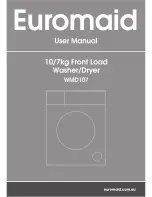
Red wine
: soak in water and detergent, rinse
and treat with acetic or citric acid, then rinse.
Treat any residual marks with bleach.
Ink
: depending on the type of ink, moisten the
fabric first with acetone
1)
, then with acetic acid;
treat any residual marks on white fabrics with
bleach and then rinse thoroughly.
Tar stains
: first treat with stain remover, me-
thylated spirits or benzine, then rub with deter-
gent paste.
Open the door by carefully pulling the
door handle outwards
Load the laundry
Place the laundry in
the drum, one item at
a time, shaking them
out as much as pos-
sible.
Maximum Loads
Recommended loads are indicated in the
«Washing Programmes».
General rules:
•
Cotton, linen
: drum full but not too tightly
packed;
•
Synthetics
: drum no more than half full;
•
Delicate fabrics and woollens
: drum no
more than one third full.
Close the door gently
Warning!
Make
sure that any
fabrics were not trap-
ped when closing the
door.
Detergents and additives
Good washing results also depend on the
choice of detergent and use of the correct
quantities to avoid waste and protect the envi-
ronment.
Although biodegradable, detergents contain
substances which, in large quantities, can up-
set the delicate balance of nature.
The choice of detergent will depend on the
type of fabric (delicates, woollens, cottons,
etc.), the colour, washing temperature and de-
gree of soiling.
All commonly available washing machine deter-
gents may be used in this appliance:
• powder detergents for all types of fabric,
• powder detergents for delicate fabrics (40°C
max) and woollens,
• liquid detergents, preferably for low tempera-
ture wash programmes (60°C max) for all
types of fabric, or special for woollens only.
The detergent dispenser drawer is provi-
ded with an insert for liquid detergent. Do
not use the insert downwards for gelatinous
detergents, with programmes including pre-
wash, with the delay start option. In all these
cases you can use metering balls or sachets
provided with the detergent, Take out the me-
tering aid at the end of the washing cycle.
Quantity of detergent to be used
The type and quantity of detergent will depend
on the type of fabric, load size, degree of soiling
and hardness of the water used.
For the quantity of detergent, refer always to
what is written on the product packing.
Use less detergent if:
• you are washing a small load,
• the laundry is lightly soiled,
• large amounts of foam form during washing.
Degrees of water hardness
Water hardness is classified in so-called “de-
grees” of hardness. Information on hardness of
the water in your area can be obtained from the
relevant water supply company, or from your lo-
cal authority.
13
www.zanussi.com
Summary of Contents for ZWH 6130 P
Page 1: ...EN User manual Washing Machine ZWH 6130 P ...
Page 29: ...29 www zanussi com ...
Page 30: ...30 www zanussi com ...
Page 31: ...31 www zanussi com ...














































